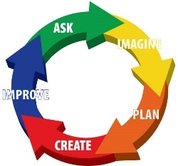 Reading. One of the key indicators of academic excellence starts when a child opens a book. Reading helps with basic speech skills, better communication skills, helps a student master the language, and creates more logical thinking skills. Students who read have better concentration skills, and exhibit more discipline in academic life. It’s no wonder schools focus so heavily on this crucial skill at an early age. Pitsco Education understands the importance of reading, and have built in strong reading components to the redesigned elementary coursework. Within the Pitsco Education Missions, students are asked to do many different activities that incorporate reading and literacy. Students have to read aloud, complete reading comprehension activities, speak and listen within their team, acquire new vocabulary, and use their writing skills. Almost daily in their Missions, students are asked to read and gather information from informational texts (nonfiction books). With the advent of the national ELA standards, literacy is significantly emphasized. The reading required of students in the Missions helps address these standards. READING IN MISSIONS Briefings
WRITING IN MISSIONS Mission Journals
SPEAKING AND LISTENING IN MISSIONS Collaboration
LANGUAGE IN MISSIONS Vocabulary words
Not bad for a STEM curriculum, right? Adding the R (Reading) and A (Arts) elements pay off for elementary students, both know and later in their academic careers. The interdisciplinary nature of the Missions allows for the reinforcement and application of reading, writing, and literacy within the teaching of science curriculum. The Pitsco Missions provide cross-curricular connections and makes the R in STREAM an integral part in the student experience. Blog adapted from the Pitsco Network Magazine, content by Tammy Pankey. See original article here.
1 Comment
 rWorkers today are called on to be subject matter experts in what they do. Gone are the days when someone can clock in and do a repetitive skill for hours. Today's workforce demands more: the same worker must now know how to assess, troubleshoot, fix, and communicate in a much more global sense. Work is less silo-ed, more interconnected with other teams. Added requirements are making it difficult for employees to stay ahead of demands, creating a skills gap. How do you train employees for these enhanced skill requirements? Many are turning to Registered Apprenticeships to fill the void. According to Why Apprenticeships are Taking Off, registered apprenticeships, not to be confused with less formal or company-specific apprentice programs, have five defining features:
Apprenticeships allow employers to hire and train workers with the necessary skills, while students can avoid an unnecessary financial burden of student loans. According to the Department of Labor, 87 percent of apprentices are employed after completing apprenticeship programs, with an average starting salary above $50,000. Registered Apprenticeship programs make a lot of sense in both urban and rural settings, and are easier to implement and facilitate than you may realize. In fact, the U.S. Department of Labor offers several registered Apprenticeship programs, backed by curriculum from leaders in education, like Amatrol. Looking to learn more, or get started today? Contact Moss for learning opportunities. Moss is proud to offer equipment and curriculum from Amatrol’s Advanced Manufacturing program. Amatrol’s industry leading equipment and curriculum is developed in partnership with industry to deliver job ready, industry relevant skills. Working closely with companies like Caterpillar, Tropicana and many others Amatrol has designed equipment for work place success.
Key Features
Want to ensure you are covering your bases and addressing the skills training most needed in your region? Check out the skills chart, which aligns coursework to job-ready skills:  How well do you know the Engineering Design Process (EDP)? How well do your students know it? If you answered “not at all” to either of those questions, think again. You likely follow some of the steps in your everyday activities. The focus of the EDP is problem solving. I’m sure you’ve problem solved already today. Deciding what to wear, which errands to complete, and where to eat are examples of everyday situations where you subconsciously use the EDP. Let’s review the steps to see if you agree.
The Engineering Design Process is something we use more often than we realize. However, many kids today do not have this same skill set and often lack problem-solving skills. So, let’s look at how a Pitsco Maker Space Project can be used to teach the EDP. The KaZoon Kite Maker Project spans all three of our leveled makerspace packages.
Blog re-printed from Pitsco Education Community Blog. Content written by Kristina Davis, Education Program Designer.
|
AuthorYou have questions about STEM education? You're not alone! We're here to share ideas and provide thought-provoking commentary. Let us know your thoughts! Sign Up for Email Updates For Email Marketing you can trust. Categories
All
Archives
February 2017
|
- Home
-
K-12
- College
- Industry
- Certifications
-
Partners
- Afinia-3D Printing
- Amatrol-Manufacturing Training Equipment
- Apolo Studios- Welding Simulation
- Bantam Tools - CNC
- CEF-Custom Educational Furniture
- DAC Worldwide-Manufacturing Training Equipment
- Greene Manufacturing Inc - Furniture
- Iconic CNC
- Interior Concepts-Furniture
- MSSC Certifications
- MINDS-i Education
- Pitsco Education-STEM
- SimLog-Heavy Equipment Simulation
- Stokes Robotics
- Techno CNC Systems
- Universal Laser Systems
- VictoryXR - Virtual Reality
- WB Mfg - Furniture
- Funding
- Contact
- About
- Home
-
K-12
- College
- Industry
- Certifications
-
Partners
- Afinia-3D Printing
- Amatrol-Manufacturing Training Equipment
- Apolo Studios- Welding Simulation
- Bantam Tools - CNC
- CEF-Custom Educational Furniture
- DAC Worldwide-Manufacturing Training Equipment
- Greene Manufacturing Inc - Furniture
- Iconic CNC
- Interior Concepts-Furniture
- MSSC Certifications
- MINDS-i Education
- Pitsco Education-STEM
- SimLog-Heavy Equipment Simulation
- Stokes Robotics
- Techno CNC Systems
- Universal Laser Systems
- VictoryXR - Virtual Reality
- WB Mfg - Furniture
- Funding
- Contact
- About


 RSS Feed
RSS Feed
